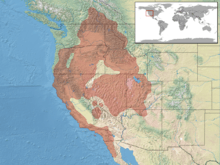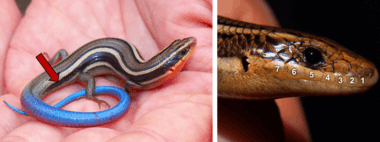Western skink
| Western skink | |
|---|---|
| | |
| Scientific classification | |
| Kingdom: | Animalia |
| Phylum: | Chordata |
| Subphylum: | Vertebrata |
| Class: | Reptilia |
| Order: | Squamata |
| Suborder: | Lacertilia |
| Infraorder: | Scincomorpha |
| Family: | Scincidae |
| Genus: | Plestiodon |
| Species: | P. skiltonianus |
| Binomial name | |
| Plestiodon skiltonianus Baird & Girard, 1852 | |
 | |
| Synonyms | |
The western skink (Plestiodon skiltonianus) is a species of small, smooth-scaled lizard with relatively small limbs. It measures about 100 to 210 mm (about 4 to 8.25 inches) in total length (body + tail). It is one of five species of lizards in Canada. They spend much of their day basking in the sun. Their diet ranges widely, including spiders and beetles. Western skinks will bite if grasped and will flee if they feel threatened. It is a common but secretive species whose range extends throughout Washington, Oregon, Nevada, Utah, and Wyoming and into western Montana and northern Arizona.They can also live in some areas of Texas[3] It is widespread in northern California but primarily restricted to the coast in central and southern California. Found in a variety of habitats, this lizard is most common in early successional stages or open areas of late successional stages. Heavy brush and densely forested areas are generally avoided.[4] Western skinks are found from sea level to at least 2,130 m (7,000 ft).[5] This diurnal reptile is active during the warm seasons.[4]
Taxonomy
Initially described in 1852 by Baird and Girard, the Western skink is named for Dr. Avery J. Skilton, who collected the first specimens. Together with Gilbert's skink (P. gilberti), the San Lucan skink (P. lagunensis), and the four-lined Asiatic skink (P. quadrilineatus), the western skink belongs to the so-called "skiltonianus group". The exact taxonomy within this group has yet to be conclusively determined, and may need revision following DNA analysis research.
(Plestiodon skiltonianus interparietalis)
There are three recognized subspecies, including the nominotypical subspecies:[2]
- Coronado skink, P.s. interparietalis (W. Tanner, 1957)
Occurs in southern California and Baja California, Mexico. - Great Basin skink, P.s. utahensis (W. Tanner, 1957)
Occurs in Utah. - Skilton's skink, P.s. skiltonianus Baird & Girard, 1852
The most common is Skilton's skink, which occurs throughout the western United States west of the Rocky Mountains and in southern British Columbia, Canada.
Behavior
The western skink is a secretive and very agile lizard that forages actively through leaf litter and dense vegetation, preying upon small invertebrates including spiders,a variety of insects and sow bugs.[3] Crickets, beetles, moths, grasshoppers, and other arthropods have been found in the stomachs of skinks.[6] Prey is sometimes stalked and cannibalism has been reported.[7] It is a good burrower and sometimes constructs burrows several times its own body length.
Habitat
Found in a variety of habitats from sea level to at least 2,130 m (7,000 ft), the western skink is commonest in early successional stages or open areas within habitats in which it occurs. Heavy brush and densely forested areas are generally avoided. The western skink seems to prefer a somewhat moist environment, although it can also be found on dry hillsides. Frequents grassland, broken chaparral, pinon-juniper and juniper-sage woodland, and open pine-oak and pine forests.[8] The soil of its nest chambers is invariably moist. Standing water is apparently not required.
Description

Aside from fading with age, the color pattern of adults varies little. They have a broad brown stripe down their backs, edged with black and bordered on each side by a conspicuous whitish to beige dorsolateral stripe that begins on nose and extends over the eye and back alongside body onto the tail. A second pale stripe, starting on upper jaw, occurs low on each side and is separated from the first by a broad dark brown or black band originating on the side of head and usually extending well out onto the tail, though this band can be disrupted if the tail is lost and regrown. Juvenile skink's tails are bright blue, turning to grey in adulthood. In the breeding season reddish or orange color appears on the side of head and chin, and occasionally on the sides, tip, and underside of the tail. They usually have seven supralabial scales and four enlarged nuchals. Young skinks' colorations are more vivid than those of adults.[8]
Geographic range
Western skinks can be found from southern British Columbia, Canada, to the tip of the Baja California Peninsula, and throughout most of Great Basin to extreme Northern Arizona; central Utah to the Pacific Coast. The species is apparently absent from the floor of San Joaquin Valley, central Sierra Nevada (except a few scattered locations in the foothills where they are very common), and lowland deserts of California. In Northern Baja, California the species occurs in the northwestern part at least as far south as Colonia Guerro and in the south in the cape and Comondu regions, Santa Agueda, and San Francisco de la Sierra. On Santa Catalina, Los Coronados, and Todos Santos Island off the coast of California.[8]
Defensive behavior
Young western skinks have a bright blue tail with color that fades with age. Skinks can perform autotomy; if seized by a predator its tail is deliberately cast and wriggles violently attracting attention while the lizard may escape.[8] The tail will grow back with time but is often darker in color and misshapen. It will play dead, but this behavior is rarely seen.
Life History
This skink is diurnal during the period of warm-season activity. During summer most activity is concentrated in the morning and late afternoon. Where summer temperatures are not extreme, activity extends throughout the day. Adult skinks usually become inactive by early fall but juveniles extend their period of activity several weeks.
The reproductive season for this species varies geographically and from year to year depending on local conditions. Mating probably occurs in the spring soon after emergence. Males turn orange on the underside when they are breeding. Females lay 2-6 eggs during June and July. Western skink females construct nest chambers that are several centimeters deep in loose moist soil. Typically these chambers are located under surface objects, especially flat stones, logs, and sometimes in or near rock outcrops.[4]
Young western skinks probably hatch in late summer, and sexual maturity may occur at 2 years of age, but most individuals probably do not reproduce until they are 3 years old. Western skinks can reach an age of up to 10 years.
References
- ↑ Hammerson, G.A. & Hollingsworth, B (2007). "plestiodon skiltonianus". IUCN Red List of Threatened Species. Version 2010.4. International Union for Conservation of Nature. Retrieved May 10, 2014.
- 1 2 The Reptile Database. www.reptile-database.org.
- 1 2 Stebbins, R. C. 1985. A Field Guide to Western Reptiles and Amphibians, Second Edition, Revised. Houghton Mifflin. Boston, Massachusetts. 336 pp.
- 1 2 3 Tanner, W.W. 1957. A Taxonomic and Ecological Study of the Western Skink (Eumeces skiltonianus). Great Basin Naturalist 17 (3-4): 59-94.
- ↑ Zeiner, D.C.; W.F. Laudenslayer, Jr.; K.E. Mayer; and M. White; eds. 1988. California's Wildlife. Vol. 1. Amphibians and Reptiles. Calififornia Dept. of Fish and Game. Sacramento, California. 272 pp.
- ↑ Taylor, E.H. 1936. A Taxonomic Study of the Cosmopolitan Scincoid Lizards of the Genus Eumeces with an Account of the Distribution and Relationship of its Species. Univ. Kansas Sci. Bull. 23: 1-643.
- ↑ Zweifel, R.G. 1952. Notes on the lizards of the Coronados Islands, Baja California, Mexico. Herpetologica 8: 9-11.
- 1 2 3 4 Stebbins, R. C. 2003. A Field Guide to Western Reptiles and Amphibians, Third Edition. Peterson Field Guide Series ®. Houghton Mifflin Company. Boston and New York. xii + 533 pp. ISBN 0-395-98272-3. (Eumeces skiltonianus, pp. 312-314 + Plate36 + Map 110.)
Further reading
- Baird, S.F., and C.F. Girard. 1852. Characteristics of some New Reptiles in the Museum of the Smithsonian Institution. Proc. Acad. Nat. Sci. Philadelphia 6: 68-70. (Plestiodon skiltonianum, p. 69.)
- Behler, J.L., and F.W. King. 1979. The Audubon Society Field Guide to North American Reptiles and Amphibians. Knopf. New York. 743 pp. ISBN 0-394-50824-6. (Eumeces skiltonianus, pp. 576–577 + Plates 421, 441-442.)
- Boulenger, G.A. 1887. Catalogue of the Lizards in the British Museum (Natural History). Second Edition. Volume III. Lacertidæ, Gerrhosauridæ, Scincidæ,... Trustees of the British Museum (Natural History). (Taylor and Francis, printers.) London. xii + 575 pp. + Plates I.- XL. (Eumeces skiltonianus, p. 373.)
- Smith, H.M. 2005. Plestiodon: a Replacement Name for Most Members of the Genus Eumeces in North America. J. Kansas Herp. (14): 15-16.
- Smith, H.M., and E.D. Brodie, Jr. 1982. Reptiles of North America: A Guide to Field Identification. Golden Press. New York. 240 pp. ISBN 0-307-13666-3. (Eumeces skiltonianus, pp. 78–79.)
